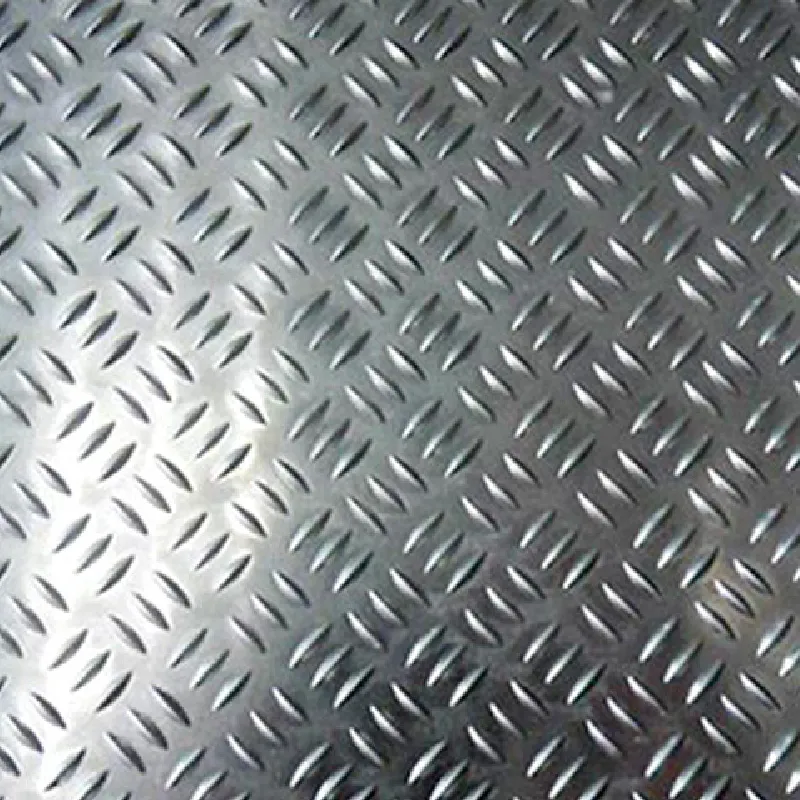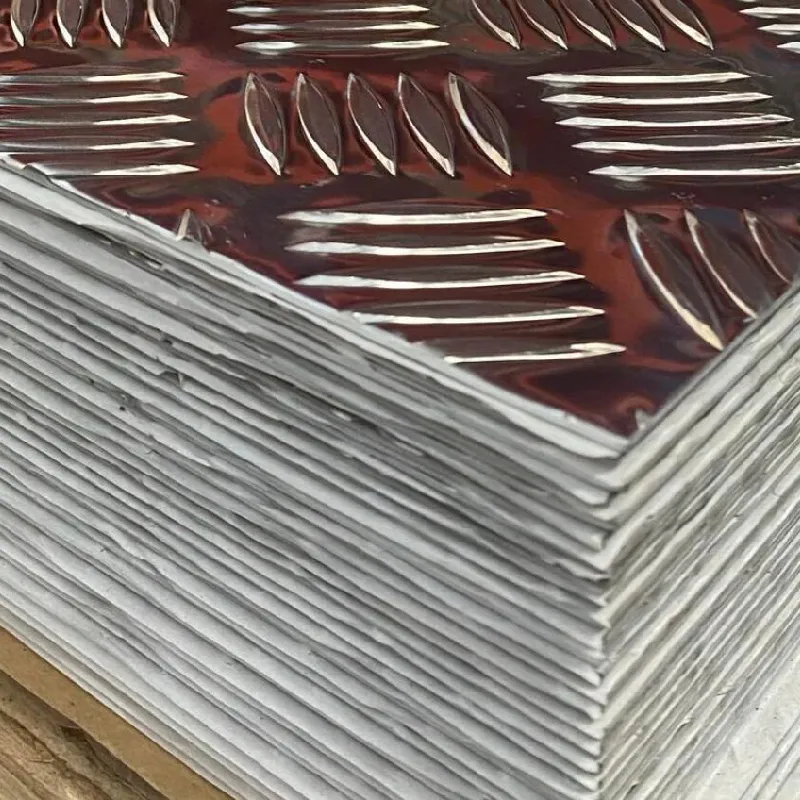In the realm of industrial design and infrastructure, safety, durability, and operational efficiency are paramount. The choice of materials significantly impacts these factors, making specialized products like the Checked Plate a critical component. Often referred to as tread plate or diamond plate, this embossed metal sheet provides superior anti-slip properties, structural integrity, and aesthetic value across a diverse array of B2B applications. Its unique raised pattern is engineered not only for enhanced friction but also for efficient fluid drainage and robust resistance to wear and tear in demanding environments.
This comprehensive guide delves into the technical aspects, market trends, and practical applications of this essential industrial material, providing B2B decision-makers and engineers with the insights necessary for optimal procurement and implementation strategies.
The industrial sector is experiencing a significant shift towards materials that offer enhanced safety, sustainability, and performance longevity. Key trends include:
These trends underscore the importance of selecting high-quality, technically superior metal plating solutions that can meet evolving industry standards and operational demands.
The production of high-grade Checked Plate involves a carefully controlled sequence of manufacturing steps, ensuring the final product meets stringent quality and performance criteria. The process emphasizes material integrity, dimensional accuracy, and consistent pattern formation.
Raw materials, typically steel (e.g., carbon steel A36, stainless steel 304/316L) or aluminum alloys (e.g., 3003, 5052), are chosen based on the application's specific requirements for strength, corrosion resistance, and weight. Coils or sheets are inspected for surface defects and material composition, often verified against international standards like ASTM, EN, or JIS.
For steel plates, the material is heated to high temperatures (typically above 900°C) and passed through a series of heavy rollers. This hot rolling process reduces the material's thickness, refines its grain structure, and prepares it for pattern imprinting.
A specialized set of embossing rollers, precisely machined with the desired pattern (e.g., diamond, teardrop, bar), presses the relief into the heated or cold-rolled plate. The pressure and temperature are carefully controlled to ensure a uniform and consistent pattern depth and definition across the entire sheet. This stage is critical for achieving the anti-slip properties.
After embossing, the plate is gradually cooled to prevent warping and internal stresses. It then undergoes a leveling process to ensure flatness and dimensional stability, crucial for subsequent fabrication and installation.
The cooled and leveled plates are precisely trimmed to specified dimensions (width and length) using high-precision shearing machines. This ensures accurate sizing for diverse applications.
Depending on the application, additional surface treatments may be applied. These include galvanizing for enhanced corrosion resistance (for steel), anodizing (for aluminum), or specialized coatings for specific environmental challenges. This greatly extends the service life in harsh environments, such as petrochemical or water supply & drainage systems.
Every batch of Checked Plate undergoes rigorous quality assurance. This includes visual inspection for pattern integrity and surface finish, dimensional checks (thickness, width, length), and mechanical property testing (tensile strength, yield strength, hardness) according to standards such as ISO 9001, ASTM A786, or EN 10025. Non-destructive testing methods may also be employed. This ensures compliance with target industries like petrochemicals and metallurgy, where safety and material integrity are non-negotiable.
This meticulous process ensures that the finished Checked Plate delivers superior performance, providing advantages such as extended service life and excellent corrosion resistance in typical application scenarios.

The effectiveness of Checked Plate hinges on its specific technical characteristics. Understanding these parameters is crucial for engineers and procurement specialists to ensure the selected product aligns precisely with project requirements and environmental conditions.
| Parameter | Carbon Steel (e.g., ASTM A36) | Stainless Steel (e.g., SS304) | Aluminum Alloy (e.g., 5052-H32) |
|---|---|---|---|
| Thickness Range (mm) | 2.5 - 10.0 | 2.0 - 6.0 | 1.5 - 8.0 |
| Standard Width (mm) | 1000, 1250, 1500 | 1000, 1219, 1500 | 1000, 1250, 1500 |
| Standard Length (mm) | 2000, 2500, 3000, 6000 | 2000, 2438, 3000 | 2000, 2500, 3000 |
| Pattern Type | 5-Bar Diamond, Teardrop | 5-Bar Diamond, Teardrop | 5-Bar Diamond, 3-Bar, 1-Bar |
| Tensile Strength (MPa) | 400 - 550 | 515 - 860 | 210 - 260 |
| Yield Strength (MPa) | Min. 250 | Min. 205 | Min. 170 |
| Hardness (HB) | 120 - 180 | 187 (Rockwell B) | 60 (Rockwell B) |
Note: Specifications may vary based on specific alloy, heat treatment, and manufacturing standards. Always refer to detailed product data sheets for precise figures.

The versatility and robust characteristics of Checked Plate make it indispensable across a wide spectrum of industrial and commercial applications. Its primary function is to provide enhanced safety and durability, particularly in environments prone to slips or heavy wear.

Selecting the right supplier for Checked Plate is as critical as choosing the material itself. A thorough vendor comparison ensures product quality, reliability, and cost-effectiveness for long-term project success. Key factors to consider include:
| Factor | Importance (1-5) | Tikemetal Offering | Competitor A (Example) | Competitor B (Example) |
|---|---|---|---|---|
| Quality Certifications (ISO 9001, ASTM, CE) | 5 | ISO 9001:2015, Material Test Certificates (MTCs), ASTM/EN compliance | ISO 9001 | Limited Certifications |
| Material Traceability | 4 | Full batch traceability, mill certs provided | Partial traceability | Limited to none |
| Customization Capabilities | 5 | Tailored dimensions, custom patterns, pre-fabrication (cutting, bending, welding) | Standard sizes only | No customization |
| Lead Times & Logistics | 4 | Efficient production, global shipping network, reliable delivery schedules | Average lead times, regional shipping | Long lead times, limited shipping options |
| Technical Support & Expertise | 5 | Dedicated engineering support, application guidance, post-sales assistance | Basic product information | No technical support |
| Pricing Structure & Value | 4 | Competitive pricing, long-term value, transparent quotes | Mid-range pricing | Low initial cost, hidden fees |
Off-the-shelf solutions rarely fit every unique industrial requirement. Recognizing this, leading manufacturers offer extensive customization options for Checked Plate to meet precise project specifications and operational demands.
Partnering with a manufacturer capable of delivering these customized solutions ensures that the Checked Plate perfectly aligns with technical requirements, budget constraints, and project timelines.
Real-world application demonstrates the tangible benefits and reliability of high-quality Checked Plate.
Client: A major petrochemical producer with extensive facilities.
Problem: Existing carbon steel walkways were showing significant signs of corrosion due to exposure to aggressive chemicals and humid environments. This led to increased maintenance costs, frequent replacements, and potential safety hazards from uneven, degraded surfaces.
Solution: We supplied custom-fabricated stainless steel (SS316L) Checked Plate. The plates were precisely cut and formed into anti-slip walkway panels and stair treads, ensuring perfect fit and rapid installation. SS316L was chosen for its superior resistance to chlorides and other harsh chemicals prevalent in the plant.
Outcome: The upgrade resulted in a dramatic reduction in corrosion-related maintenance, extending the service life of the walkways by over 150%. Workplace safety improved significantly, with zero reported slip incidents on the new surfaces. The client reported substantial long-term cost savings and enhanced operational continuity, reinforcing their trust in high-grade materials and expert fabrication.
Client: An international offshore energy company.
Problem: The existing decking on several offshore platforms was heavy, contributing to structural load, and prone to rapid corrosion from constant saltwater exposure. This necessitated frequent and costly repairs in challenging offshore conditions.
Solution: Lightweight aluminum alloy (5083-H116) Checked Plate was custom-designed and supplied. This specific aluminum alloy is renowned for its exceptional resistance to marine environments and high strength-to-weight ratio. The plates were supplied pre-cut and pre-drilled to integrate seamlessly with the platform's existing framework.
Outcome: The switch to aluminum Checked Plate reduced the overall deck weight by approximately 30%, which indirectly contributed to energy saving for platform operations. Its superior corrosion resistance drastically extended the maintenance cycle, reducing operational downtime and associated costs. Crew feedback highlighted improved safety due to the consistent anti-slip surface, even in rough sea conditions. This project showcased the material's suitability for harsh marine applications and our capability in delivering specialized solutions.
These case studies highlight our commitment to delivering superior Checked Plate solutions that address complex industrial challenges, demonstrating both product excellence and customer-centric service.
Our commitment to reliability extends beyond product quality to comprehensive operational support, fostering long-term trust with our B2B partners.
We understand the critical nature of project timelines. Our production facilities are optimized for efficiency, combining advanced manufacturing techniques with stringent quality control. We offer flexible production schedules, global shipping capabilities, and transparent logistics tracking to ensure your order of Checked Plate arrives on time and as specified. For large-scale or highly customized orders, detailed project plans and communication schedules are established upfront.
All our Checked Plate products are manufactured under strict quality assurance protocols, adhering to international standards such as ISO 9001. We provide comprehensive warranties against manufacturing defects and material failures, ensuring your investment is protected. Specific warranty details are provided with each quotation, reflecting our confidence in product durability and performance.
Our dedicated technical and sales support teams are available to assist with product selection, technical specifications, custom solutions, and post-sales inquiries. With decades of experience in the metal industry and a team of qualified engineers, we provide expert guidance to ensure optimal product application and customer satisfaction. Reach out via our website or direct contact channels for personalized assistance.
The selection of high-quality Checked Plate is a strategic decision that significantly impacts operational safety, longevity, and cost-efficiency across various industrial sectors. From robust manufacturing processes adhering to international standards to bespoke customization options and unwavering customer support, the value proposition of a reliable Checked Plate supplier is undeniable. By understanding the technical parameters, application versatility, and the critical importance of vendor trustworthiness, B2B decision-makers can ensure they procure materials that not only meet but exceed demanding industrial requirements, paving the way for safer, more durable, and more efficient infrastructure.
RELATED PRODUCTS